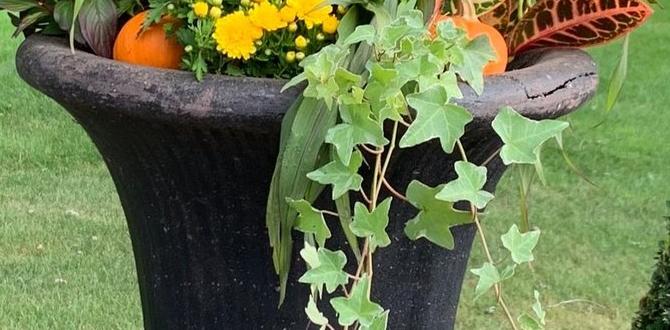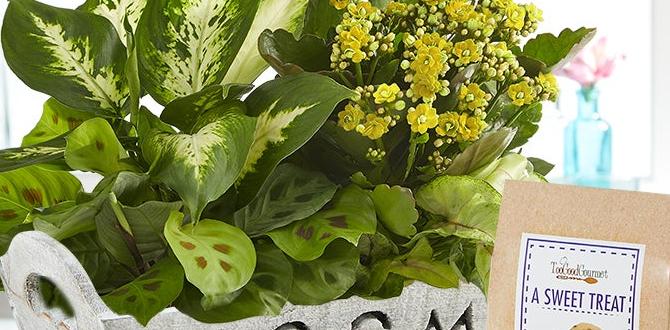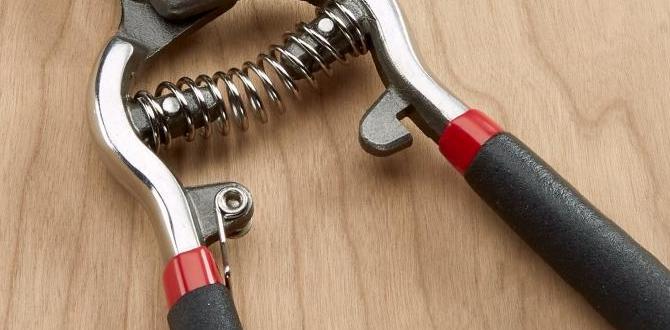Early spring planting is achievable with the right knowledge! This guide offers proven tips for successful seed starting indoors and direct sowing outdoors, ensuring a bountiful garden even when the weather is unpredictable. Get ready to grow vibrantly!
Early Spring Planting: Proven Tips For Success
The urge to get our hands dirty and start planting often strikes when the first hints of spring appear, but the weather can be notoriously fickle. You might be excited to sow seeds, only to see frost return, sadly wilting your tender seedlings. It’s a common frustration for new gardeners, leaving you wondering if you missed your chance or planted too soon. But don’t worry! With a few smart strategies, you can embrace early spring planting and set your garden up for a thriving season right from the start. We’ll walk you through everything you need to know, from understanding your climate to choosing the right plants and giving them the best possible start, both indoors and out.
Understanding Your Planting Window: The Key to Early Spring Success
Before a single seed is sown, the most crucial step is understanding your local climate and its impact on planting times. This isn’t just about the calendar; it’s about soil temperature, frost dates, and the specific needs of each plant. Getting this right is the bedrock of successful early spring planting.
Know Your Frost Dates
The most vital piece of information for any gardener is knowing your region’s average last frost date. This is the date after which the risk of frost is very low. You can find reliable frost date information from resources like the National Weather Service or your local cooperative extension office. Even after the last frost date, unusually cold snaps can occur, so it’s always wise to keep an eye on the extended forecast.
- Why it matters: Planting frost-sensitive plants too early can lead to them being damaged or killed by unexpected freezes.
- Actionable Tip: Mark your average last frost date on a calendar. Many planting guides will reference this date.
Soil Temperature is Crucial
While air temperature matters, soil temperature is paramount for seed germination and root development. Some seeds, like peas and spinach, can germinate in cool soil, around 40°F (4°C). Others, like tomatoes and peppers, need much warmer soil, typically above 60°F (15°C).
- Testing your soil: You can use a simple soil thermometer. Insert it a few inches into the soil in a sunny spot where you plan to plant.
- Warming the soil: For earlier planting in cooler climates, consider using row covers, cloches, or black plastic mulch to help warm the soil a few weeks before you plan to sow.
Listen to Your Local Growing Conditions
Every garden is unique. Hillsides, low-lying areas, and even proximity to buildings can affect microclimates. Pay attention to when the snow melts in your specific garden and how quickly the soil dries out after rain.
- Observe your surroundings: Notice when local trees bud and when wildflowers typically bloom. These are natural indicators of the growing season beginning.
- Talk to experienced neighbors: Local gardeners often have invaluable knowledge about their area’s specific growing quirks.
Indoor Seed Starting: Getting a Head Start
For many popular vegetables and flowers, starting seeds indoors is the best way to get a jump on the season. This allows plants to develop a strong root system before being transplanted into the garden, and it’s a fantastic way to grow plants that require a longer growing season.
Essential Supplies for Indoor Seed Starting
You don’t need a fancy setup to start seeds indoors. A few key items will set you up for success:
- Seed starting trays or pots: These can be small plastic cells, peat pots, or even recycled yogurt cups with drainage holes.
- Seed starting mix: A sterile, well-draining mix is crucial to prevent damping off (a fungal disease). Avoid using garden soil.
- Seeds: Choose varieties suited for your climate and the space you have.
- Light source: A sunny windowsill can work for some plants, but grow lights are often necessary for strong, stocky seedlings. Visit The Royal Horticultural Society’s guide on seed raising for excellent tips and visual aids.
- Watering can or spray bottle: For gentle watering.
- Labels: Essential for keeping track of what you’ve sown.
The Indoor Seed Starting Process: Step-by-Step
Here’s how to get your seeds germinating and growing strong indoors:
- Prepare your containers: Fill trays or pots with moist seed starting mix. Don’t pack it too tightly.
- Sow your seeds: Read the seed packet carefully for depth instructions. Generally, plant seeds at a depth twice their diameter. Place 1-3 seeds per cell/pot.
- Water gently: Use a mister or a very fine spray to moisten the surface without disturbing the seeds.
- Provide warmth: Some seeds, like peppers, benefit from extra warmth. A heat mat can be very effective for consistent germination temperatures.
- Provide light: Once seedlings emerge, they need plenty of light. If using grow lights, keep them just a few inches above the seedlings and run them for 14-16 hours a day.
- Maintain moisture: Keep the soil consistently moist but not waterlogged. Allowing the surface to dry slightly between waterings can prevent mold.
- Ventilation: Good air circulation helps prevent disease. A small fan on a low setting can be beneficial.
Hardening Off: The Crucial Transition
Before transplanting seedlings outdoors, they must be “hardened off.” This process acclimates them to the harsher outdoor conditions – wind, direct sun, and cooler temperatures. Skipping this step can shock your plants and set them back significantly, or even kill them.
- Start gradually: About a week to ten days before transplanting, begin placing seedlings outdoors in a sheltered spot for a few hours each day.
- Increase exposure: Each day, gradually increase the time they spend outdoors and expose them to more direct sunlight.
- Bring them in: Always bring tender seedlings indoors at night, especially if there’s any risk of frost.
- Observe for stress: Watch for wilting or yellowing leaves, which can indicate they’re getting too much sun or wind too soon.
Direct Spring Planting: Sowing Seeds Outdoors
Some plants are tough enough to be sown directly into the garden soil as soon as the ground can be worked and is no longer frozen. These are often called “cool-season crops” because they thrive in cooler temperatures.
Cool-Season Crops to Plant Early
These hardy vegetables and herbs can often be planted weeks before your last frost date, provided the soil isn’t waterlogged and is workable.
- Leafy Greens: Lettuce, spinach, arugula, kale, swiss chard.
- Root Vegetables: Carrots, radishes, beets, turnips, parsnips.
- Legumes: Peas (shelling peas, snow peas, snap peas).
- Alliums: Onions (from sets or seeds), leeks.
- Brassicas: Broccoli, cauliflower, cabbage, Brussels sprouts (often best started indoors and transplanted out earlier, but direct sowing is possible in some climates).
- Herbs: Parsley, cilantro, dill, chives.
Preparing Your Garden Beds for Direct Sowing
Good soil preparation is key for successful direct sowing.
- Clear Debris: Remove any remaining leaves, weeds, or debris from last season.
- Loosen Soil: Gently turn the soil to a depth of about 6-8 inches using a spade or garden fork. This ensures good drainage and allows roots to penetrate easily. This is also a good time to incorporate compost.
- Amend the Soil: If your soil is heavy clay or very sandy, incorporate organic matter such as compost or well-rotted manure. This improves soil structure, drainage, and fertility. You can find more details on soil improvement on the EPA’s page on composting.
- Rake Smooth: Use a rake to break up any large clumps of soil and create a level, fine surface for sowing seeds.
Direct Sowing Best Practices
- Follow Seed Packet Instructions: These are your best guide for planting depth, spacing, and desired soil temperatures.
- Sow at the Correct Depth: Too deep, and seeds may not germinate; too shallow, and they may dry out.
- Water Gently: After sowing, water the area gently but thoroughly. A fine spray from a hose or a watering can with a rose attachment is ideal.
- Mulch (Optional but Recommended): A light layer of straw or compost can help retain moisture and prevent soil erosion, especially if you live in a windy area.
- Use Row Covers or Cold Frames: For additional protection against late frosts and to retain soil moisture and warmth, consider using lightweight row covers, cloches, or a cold frame.
Table: Cool-Season Vegetables and Their Optimal Planting Times
This table provides a general guideline. Always adjust based on your specific climate and frost dates.
| Vegetable | When to Sow (Weeks Before Last Frost) | Soil Temperature (°F) | Notes |
|---|---|---|---|
| Peas | 4-6 weeks | 40-60°F (4-15°C) | Need support for climbing. |
| Spinach | 4-6 weeks | 35-65°F (2-18°C) | Can bolt (go to seed) in heat. |
| Radishes | 2-4 weeks | 45-65°F (7-18°C) | Fast growers, good for succession planting. |
| Carrots | 2-3 weeks | 45-70°F (7-21°C) | Require loose, stone-free soil. |
| Lettuce (Loose Leaf) | 2-4 weeks | 40-70°F (4-21°C) | Succession sow every 2-3 weeks. |
| Kale | 2-4 weeks | 40-70°F (4-21°C) | Very hardy, excellent for early and fall harvest. |
| Broccoli (Transplants) | 4-6 weeks before last frost | 50-70°F (10-21°C) | Start seeds indoors 4-6 weeks prior. |
Protecting Your Young Plants from the Elements
Early spring weather can be unpredictable, and even hardy plants can be vulnerable to late frosts, harsh winds, and heavy rain. Employing protective measures can safeguard your investment and ensure your plants thrive.
Row Covers and Tunnels
Lightweight fabric row covers are a gardener’s best friend in early spring. They can be draped directly over plants or supported by hoops to create small tunnels. These covers offer several benefits:
- Frost Protection: They can add a few degrees of protection, often enough to save plants from a light frost.
- Pest Barrier: They also act as a physical barrier against insects, preventing them from reaching your young plants.
- Wind Protection: They buffer plants against strong, drying winds.
- Moisture Retention: They help keep moisture in the soil.
Cloches and Cold Frames
Cloches are individual plant covers, often made of glass or plastic, that create a mini-greenhouse effect for a single plant or small cluster. Cold frames are larger, box-like structures with transparent lids, perfect for protecting larger areas of seedlings or even overwintering some plants.
- Cold Frames: These are excellent for hardening off seedlings or for giving a significant head start to crops like lettuce and spinach. They can be built from scratch or purchased. For DIY ideas, check out resources on building basic cold frames.
- DIY Cloches: Large plastic bottles with the bottoms cut off can serve as effective homemade cloches. Ensure they have some ventilation on warm days.
Watering Wisely
In early spring, the soil may still be cool and can retain moisture for longer periods. Overwatering can lead to fungal diseases and root rot. Here’s how to water effectively:
- Check the soil moisture: Stick your finger about an inch or two into the soil. If it feels moist, hold off on watering.
- Water in the morning: This allows foliage to dry before nightfall, reducing disease risk.
- Water at the base: Aim to water the soil directly rather than the leaves.
- When to water more: As temperatures rise and plants grow, they will require more frequent watering.
Choosing the Right Plants for Early Spring
Not all plants are created equal when it comes to early spring planting. Some varieties are naturally more cold-tolerant and can establish themselves while temperatures are still cool.
Cold-Tolerant Vegetables & Herbs
Focusing your earliest efforts on these resilient plants will yield the best results:
- Root Vegetables: Radishes, carrots, beets, turnips, parsnips. Their roots develop steadily in cool soil.
- Leafy Greens: Spinach, kale, lettuce, arugula, swiss chard. Many of these can even withstand a light frost.
- Peas: These nitrogen-fixing legumes actually prefer cooler weather and will start producing earlier when sown in early spring.
- Brassicas: Broccoli, cabbage, cauliflower, Brussels sprouts. While tender when young, they can be transplanted out early and will grow stronger as temperatures moderate.
- Onions and Leeks: They are quite hardy and benefit from a long growing season.
Consider Your Climate and Soil
Even within the “cool-season” category, there are differences. For example, some lettuce varieties tolerate a wider range of cool temperatures than others. Always check the specific variety’s description for its hardiness.
- Regional Variations: What’s considered “early” in one region might be too late for another. Always refer back to your local last frost date.
- Soil Drainage: Ensure your planting area has good drainage. Cool, soggy soil is a recipe for disaster for most seeds and young plants.
Table: Popular Early Spring Flowers
Adding flowers to your early spring garden not only brings color but also attracts beneficial insects. Many of these can be started indoors or sown directly.
| Flower | When to Sow (Direct) | When to Transplant (Indoors Started) | Notes |
|---|---|---|---|
| Pansies & Violas | Fall for overwintering; 4-6 weeks before last frost | 4-6 weeks before last frost | Very cold-tolerant once established. |
| Snapdragons | 4-6 weeks before last frost (cover lightly) | 6-8 weeks before last frost | Benefit from protection from harsh weather. |
| Calendula | 2-4 weeks before last frost | 4-6 weeks before last frost | Easy to grow, reseeds readily. |
| Poppies (e.g., California Poppy) | As soon as soil can be worked (do not cover deeply) | N/A (direct sow is best) | Prefer undisturbed soil. |
| Sweet Peas | 4-6 weeks before last frost (soak seeds first) | 4-6 weeks before last frost | Need support to climb. |
Addressing Common Early Spring Planting Challenges
Even with the best intentions, early spring planting can present unique challenges. Forewarned is forearmed!
Challenge 1: Unpredictable Frosts
The Problem: You planted your tender seedlings, and an unexpected forecast shows a late frost.
The Solution: Be prepared! Have frost cloths, old blankets, or even buckets ready to cover susceptible plants overnight. For plants in containers, you can simply move them to a sheltered location. Don’t forget that row covers, mentioned earlier, are excellent for this. A good resource for understanding frost and its impact can be found at NOAA’s National Weather Service.
Challenge 2: Soil Too Wet
The Problem: The ground is soggy, making it impossible to work.
The Solution: Patience is key. Trying to work




